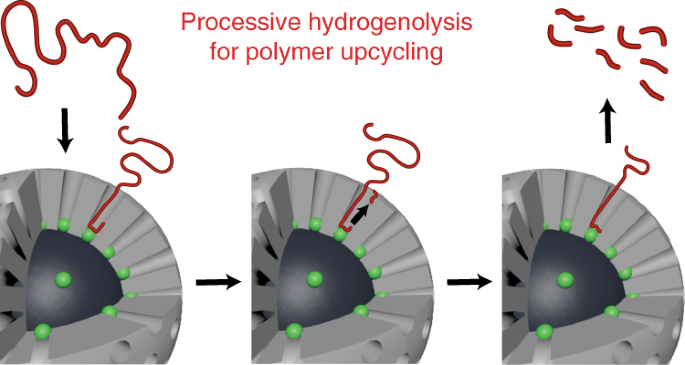(A first-of-its-kind catalyst mimics natural processes to break down plastic and produce valuable new products)
2020/10/14 アメリカ合衆国(DOE)・エイムズ国立研究所

・ エイムズ国立研究所が率いる複数機関から成る研究チームが、ポリエチレンやポリプロピレン等(レジ袋やシャンプーボトル等で使用される)のポリオレフィンプラスチックを有用な化学物質に分解する、極めてユニークな触媒を開発。
・ 同触媒のプロセスは、タンパク質やセルロースのような高分子を的確に分解する酵素の働きに着想を得たもの。同触媒は、触媒活性部位の白金コアを中心とし、シリカの長いチャネルで囲まれたメソポーラスシリカのナノ粒子。シリカのチャネルを通り抜けたポリマーの長鎖を、新しく有用な製品へとアップサイクル可能な均一な短鎖に分解する。
・ 無機材料をベースとしたこのような被制御触媒プロセスの設計は、今回が初めての例となる。同触媒プロセスでは、同一分子において複数回の同一の分解ステップを実行。原子スケールでの触媒活性の精査にて、酵素による分解プロセスのように、ポリマー長鎖が触媒のチャネルを容易に通り抜けることを確認した。
・ 同触媒の研究は、エイムズ国立研究所が率いる Inistitute for Cooperative Upcycling of Plastics (iCOUP)の指揮の下、継続して実施予定。iCOUP は、エイムズ国立研究所、アルゴンヌ国立研究所、カリフォルニア大学サンタバーバラ校(UCSB)、南カリフォルニア大学、コーネル大学、ノースウェスタン大学およびイリノイ大学アーバナ・シャンペーン校の科学者らから構成される Energy Frontier Research Center である。
URL: https://www.ameslab.gov/news/a-first-of-its-kind-catalyst-mimics-natural-processes-tobreak-down-plastic-and-produce
<NEDO海外技術情報より>
(関連情報)
Nature Catalysis 掲載論文(アブストラクトのみ:全文は有料)
Catalytic upcycling of high-density polyethylene via a processive mechanism
URL: https://www.nature.com/articles/s41929-020-00519-4
Abstract
The overconsumption of single-use plastics is creating a global waste catastrophe, with widespread environmental, economic and health-related consequences. Here we show that the benefits of processive enzyme-catalysed conversions of biomacromolecules can be leveraged to affect the selective hydrogenolysis of high-density polyethylene into a narrow distribution of diesel and lubricant-range alkanes using an ordered, mesoporous shell/active site/core catalyst architecture that incorporates catalytic platinum sites at the base of the mesopores. Solid-state nuclear magnetic resonance revealed that long hydrocarbon macromolecules readily move within the pores of this catalyst, with a subsequent escape being inhibited by polymer–surface interactions, a behaviour that resembles the binding and translocation of macromolecules in the catalytic cleft of processive enzymes. Accordingly, the hydrogenolysis of polyethylene with this catalyst proceeds processively to yield a reliable, narrow and tunable stream of alkane products.



